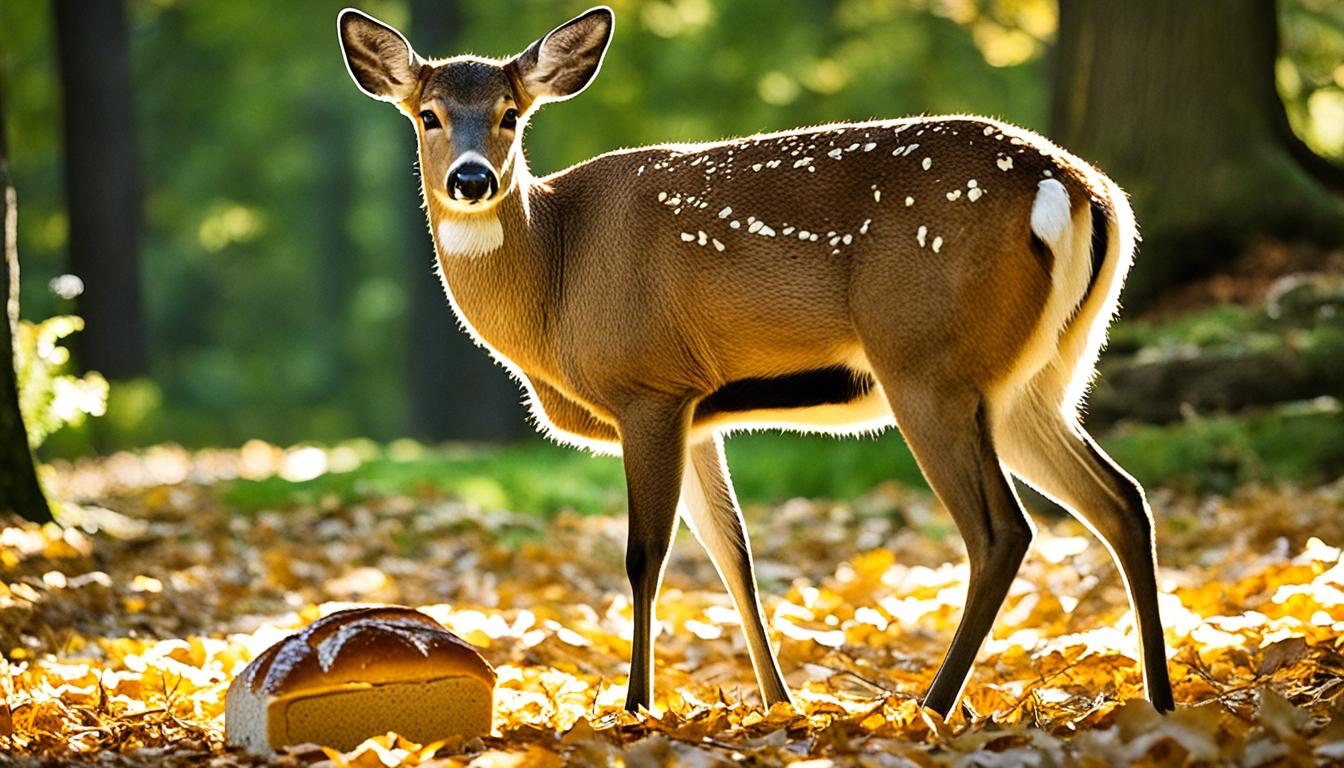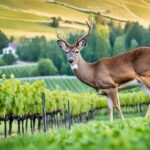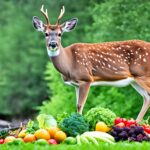Feeding deer is a common practice among wildlife enthusiasts, but it’s important to understand their dietary needs and the potential risks involved. One popular question that arises is whether deer can eat bread. Let’s delve into this topic and explore the implications of feeding bread to deer.
While bread can be enjoyed by deer, it should be provided responsibly and in moderation. Deer have specific dietary requirements, and their digestive systems require a gradual introduction to new foods. Giving them excessive amounts of bread can lead to gastrointestinal issues and even put their lives at risk.
Content Highlights
ToggleKey Takeaways:
- Deer can eat bread, but it should be given in controlled amounts.
- Feeding large quantities of bread to deer can cause gastrointestinal issues and even death.
- Deer require a balanced diet that includes natural food sources such as woody browse, leaves, and fruits.
- Excessive bread feeding can lead to overpopulation, disease spread, and habitat damage.
- Responsibly providing a diverse diet is crucial for the health and well-being of deer.
The Nutritional Content of Bread for Deer
Different types of bread have varying nutritional content. White bread, brown bread, and multigrain bread all contain different amounts of calories, carbohydrates, protein, fat, fiber, vitamins, and minerals. While bread can provide essential nutrients for deer, it is important to feed them a balanced diet and not rely solely on bread as a food source. Other natural foods such as woody browse, leaves, twigs, and fruits should also be included in their diet.
The Risks of Feeding Bread to Deer
Feeding large quantities of bread to deer can have several negative impacts on their health, behavior, and the environment. While deer may be attracted to bread and readily consume it, it is essential to understand the potential risks associated with this practice.
Increased Risk of Overpopulation
Regularly feeding deer with bread can disrupt their natural foraging patterns and lead to an overreliance on supplemental feeding. When deer become dependent on bread as a food source, it can contribute to overpopulation, as they are more likely to reproduce and survive in larger numbers.
Spread of Communicable Diseases
Concentrating deer around bread feeding sites can create crowded conditions that facilitate the spread of communicable diseases within the deer population. Close proximity increases the likelihood of transmission, potentially devastating deer populations and harming wildlife ecosystems.
Environmental Damage
Feeding bread to deer attracts them to specific locations, leading to increased grazing pressure on the surrounding vegetation. Overgrazing can damage the natural habitat, disrupting the balance of the ecosystem and negatively impacting other wildlife species that rely on the same resources.
Predator Attraction
Feeding deer with bread can attract predators to the area. Predators, such as coyotes or wolves, may take advantage of concentrated deer populations and pose a threat to the overall well-being of the deer. Interactions between predators and deer can be detrimental to both populations and disrupt the natural predator-prey dynamics.
Increased Traffic Accidents
Feeding deer with bread near inhabited areas can increase the risk of traffic accidents. Bread feeding sites often lead to deer crossing roads more frequently, putting both the deer and motorists at a higher risk of collisions. This poses a danger to human safety and can result in severe injuries or fatalities.
To ensure the health and welfare of deer, it is crucial to consider the potential risks before deciding to feed bread to them. Feeding deer a diverse and natural diet that aligns with their nutritional needs and foraging habits is the best approach to support their well-being and preserve the delicate balance of wildlife ecosystems.

| Risks of Feeding Bread to Deer | Description |
|---|---|
| Increased Risk of Overpopulation | Feeding deer with bread can lead to overpopulation as they become dependent on supplemental feeding. |
| Spread of Communicable Diseases | Bread feeding sites can facilitate the transmission of communicable diseases among deer populations. |
| Environmental Damage | Feeding deer with bread concentrates them in certain areas, causing overgrazing and harming the natural habitat. |
| Predator Attraction | Bread feeding can attract predators, disrupting the predator-prey dynamics and endangering both populations. |
| Increased Traffic Accidents | Feeding deer with bread near inhabited areas can lead to more frequent deer crossings, increasing the risk of accidents. |
Conclusion
Feeding bread to deer can be a part of their diet, but it should be done in moderation and not as their sole or primary food source. While bread can provide some nutritional benefits, it is important to consider the risks involved in feeding deer this particular type of food. Overpopulation and the spread of diseases are among the potential negative effects of relying heavily on bread for deer nutrition.
To ensure the health and well-being of deer, it is crucial to provide them with a diverse and natural food source. Including woody browse, leaves, and fruits in their diet not only meets their nutritional needs but also encourages a balanced and sustainable feeding behavior. By promoting a combination of natural foods, we can help maintain a healthy deer population and preserve their natural habitat.
Therefore, if you choose to feed bread to deer, remember to do so responsibly, offering it as an occasional treat rather than a staple. Using bread as a supplement to their diet can be a way to diversify their nutrition while still prioritizing their overall well-being and natural feeding habits.
- California Deer Hunting Guide: Seasons, Rules, Permits, and More - 26 June 2024
- Arkansas Deer Season 2024 [Schedules, Licenses, Bag Limits & More!] - 26 June 2024
- 2024 Arizona Deer Season New Dates & Rules! - 25 June 2024




